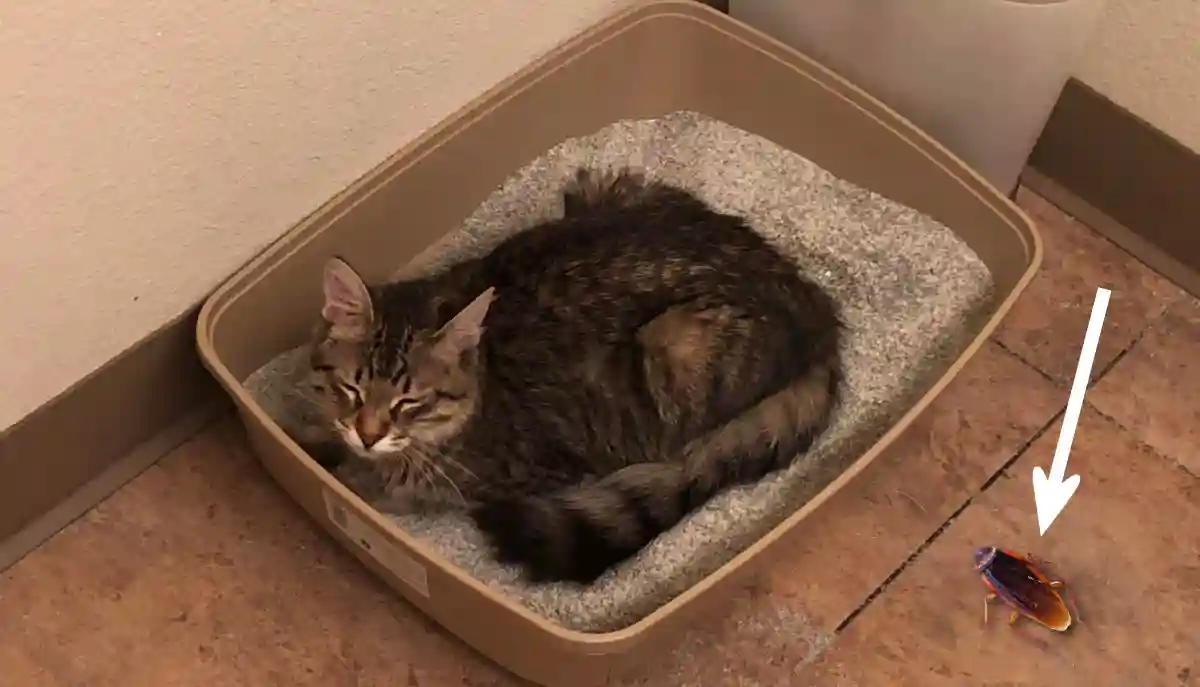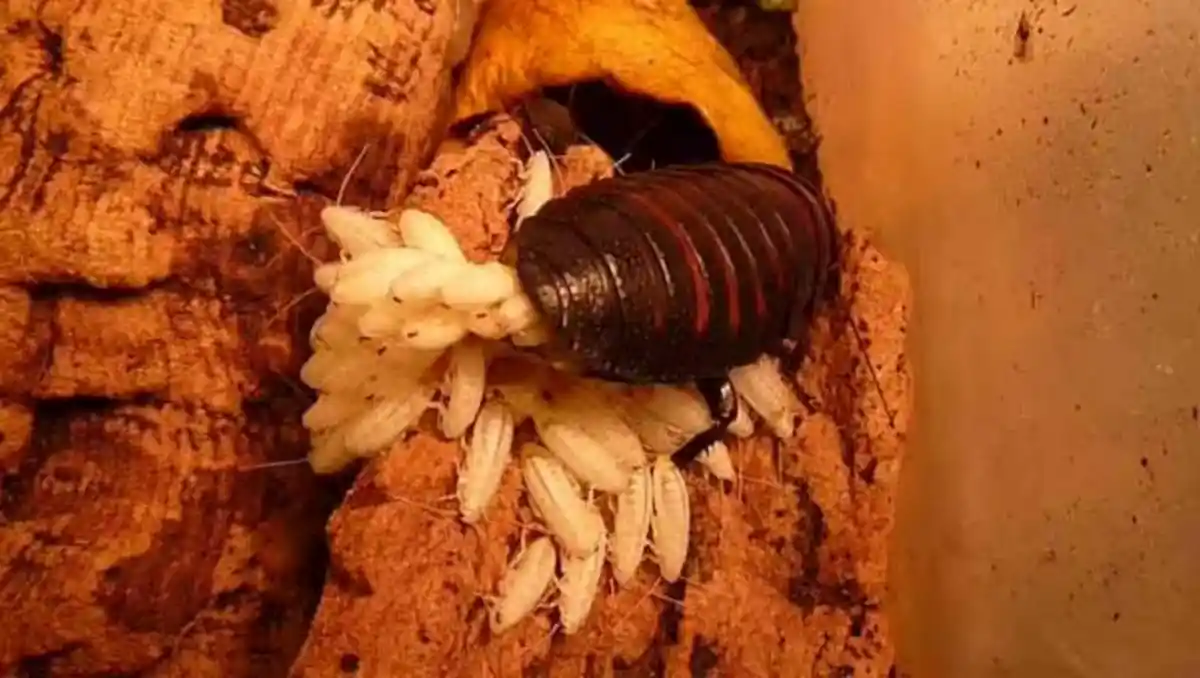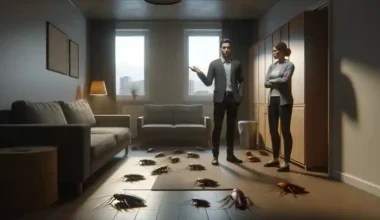Cockroach on its back but alive? Even to those who have grown up in an environment where cockroaches are a common sight, the sight of a cockroach on its back but alive is startling and often bewildering. The cockroach, an insect often associated with dirt and filth, becomes a subject of curiosity when we see it lying on its back, its legs twitching in the air. The sight is both repulsive and fascinating.
The cockroach is a symbol of survival, a creature that has evolved and adapted over millions of years to withstand a myriad of environmental changes. From massive shifts in climate to the onslaught of chemical warfare in the form of pesticides, the cockroach’s resiliency has become a topic of intense scientific study. Yet, how could such a resilient creature end up on its back, seemingly struggling for life?
Cockroach On Its Back But Alive? Here Are Common Myths

There’s a common misconception that a cockroach on its back is a sign of death or near death. However, in many cases, the cockroach is far from dead. It’s a spectacle that puzzles many, prompting questions as to why an insect famous for its survivability finds itself in such a predicament.
An examination of the cockroach’s physical attributes and behaviors can provide some insights. For one, the cockroach has a rounded and slick back, while its legs are angled towards the ground. This body structure aids the cockroach in maneuvering across different surfaces, squeezing into tight spaces, and moving with impressive speed. However, the same evolutionary design can also be a drawback.
If a cockroach is flipped onto its back, it can struggle to return to an upright position. The slickness of its back and the angle of its legs work against it, making it difficult for the insect to gain traction and flip back over.
When a cockroach finds itself on its back, it’s not always due to external forces. Sometimes, it’s self-induced. This behavior is often observed when a cockroach molts – a process by which it sheds its old exoskeleton to grow. During molting, a cockroach may momentarily lose its balance and end up on its back. However, once the molting process is complete, it typically manages to flip back over and scuttle away.
Reasons a Roach is on Its Back
A cockroach on its back but alive could be the result of a lethal encounter with insecticides. Many commonly used insecticides affect the cockroach’s nervous system, causing it to experience muscle spasms and convulsions.
This can result in the cockroach flipping onto its back, unable to right itself. But even in this state, the cockroach may not be dead yet. Depending on the potency of the insecticide and the resilience of the cockroach, it can remain in this state for several hours or even days before succumbing.
However, the explanations may not entirely account for the instances where a seemingly healthy cockroach ends up on its back. After all, a cockroach doesn’t need to molt frequently, and not every upside-down cockroach has been in contact with insecticides. Scientists speculate that such occurrences could be due to the cockroach’s age or health condition, just like older or sickly humans are more prone to falls.
A cockroach on its back, alive yet helpless, becomes a symbol of a struggle for survival – not just against environmental challenges, but against its own physical limitations. It’s a testament to the cockroach’s impressive adaptability, but also a reminder of its vulnerability. It might even induce a sense of empathy in us, a reminder of our own struggles and resilience.
What to Do if You Saw a Live Cockroach on Its Back
If you’ve seen a live cockroach on its back, it might be struggling or injured but not necessarily dead, as cockroaches can survive in difficult conditions. Here’s what you can do:
1. Leave it alone or kill it
Depending on your stance towards bugs in general, you might choose to either leave it alone or kill it., especially if you keep finding cockroaches on their back. You could use a shoe or any hard object, or you could use bug spray if you have some on hand. Do remember that killing it might leave behind a mess that you’ll have to clean up.
2. Catch and Release
If you’re not comfortable with killing it but don’t want it in your house, you could use a cup and a piece of paper to trap the cockroach and then release it outside.
3. Contact Pest Control
If you’re seeing a cockroach in your house, it might not be the only one. Cockroaches tend to be part of larger infestations. If you’re uncomfortable dealing with this issue or if you’ve seen more than one cockroach, you might want to consider contacting a professional pest control service. They have experience dealing with these situations and can help ensure that all cockroaches (and their eggs) are eliminated from your home.
4. Prevent Future Infestations
After you’ve dealt with the immediate issue, you should take steps to prevent future infestations. This includes cleaning up food scraps and crumbs promptly, sealing off potential entry points, and regularly checking damp, dark areas of your home (where cockroaches tend to breed) for signs of infestation.
5. Use Insect Traps
Cockroach traps available in the market can help you understand the extent of the infestation. They are small boxes coated with an adhesive that can trap cockroaches. Place them in areas where you’ve seen cockroaches, like under the fridge, sinks, and cabinets. These traps not only kill individual roaches but can also help you track where most of the activity is happening.
6. Apply Insecticides
There are a number of commercial insecticides available for use against cockroaches, including sprays and bait stations. Bait stations, in particular, can be effective because they contain a poison that the roach takes back to the nest, potentially killing others. Always follow the instructions on the package and take necessary precautions when handling chemicals.
7. Use Natural Repellents
If you prefer a more natural approach and you keep finding cockroaches on their back, certain essential oils like peppermint oil and tea tree oil are said to repel cockroaches. Mix a few drops of the essential oil with water in a spray bottle and spray it around possible entry points. This can deter cockroaches from coming into your home. Other natural repellents include substances like diatomaceous earth or borax, which can be spread in areas where cockroaches have been seen. We explained in detail how you can keep roaches off using bay leaves.
8. Regularly Inspect Your Home
Regular inspections can help you spot signs of an infestation early before it becomes too large. Look for signs like fecal droppings, egg cases, or dead roaches.
You also want to practice good sanitation. Cockroaches are attracted to food and water sources. Keep your kitchen and dining areas clean. Don’t leave dishes in the sink overnight, store food in airtight containers, regularly take out the trash, and avoid clutter where possible.
Since cockroaches are attracted to moisture, fix any leaky pipes and ensure areas like basements and crawl spaces are well-ventilated and dry.
Lastly, fix the leaks. Cockroaches can enter homes through small cracks and holes, so take the time to seal up any gaps, especially around doors, windows, and where utility pipes enter the home.
What Does It Mean if a Cockroach is On Its Back?
A cockroach on its back but alive generally signifies a state of distress or weakness. Unlike many other insects, cockroaches are adept at navigating various terrains, including flipping over if they find themselves on their backs. Therefore, seeing one stuck in this position typically signals an underlying problem.
There are several possible explanations for why a cockroach might end up on its back:
1. Old age or sickness
As cockroaches age or become ill, their physical abilities can diminish. Sometimes, their legs or body structures weaken, making it hard for them to flip back over when they end up on their backs. If you find a cockroach in this state, it might be nearing the end of its life or battling an illness.
2. Exposure to insecticides
If a cockroach is seen on its back and appears to be struggling, it could be due to exposure to pesticides or insecticides. These chemicals are designed to kill pests, often by attacking their nervous systems. This can cause cockroaches to lose control over their movements and end up stuck on their backs. Some insecticides may also induce paralysis, leading to a similar outcome.
3. Physical trauma
An injury can also leave a cockroach on its back. If it’s been stepped on, swatted, or otherwise injured, it might not have the strength or ability to right itself.
4. Dehydration or starvation
Oriental cockroaches, for example, can live for a month without food, but only 2 weeks without water – Nebraska Extension in Lancaster County. If they’re deprived of these essentials, they can become weak, which might cause them to end up on their backs.
5. Birth defect or genetic abnormality
On rare occasions, a cockroach might have a birth defect or genetic abnormality that prevents it from being able to navigate as effectively as its counterparts. These cases are quite unusual, but they can occur.
Can a Cockroach Survive On Its Back?
When stuck on their backs, cockroach mobility is significantly reduced, which can impact their ability to find food and water. Hence, their survival would depend on how long they can withstand these deprivations.
The reason why the cockroach is on its back can also influence its survivability. If the cockroach ended up in that position due to old age, illness, physical injury, or exposure to insecticides, it is likely already weakened and may not survive for long.
These factors can cause physical debilitation or disrupt their nervous systems, reducing their ability to navigate or seek sustenance.
Generally, a healthy and uninjured cockroach should be able to flip itself back onto its feet within a short period. Therefore, if you see a cockroach on its back but alive for an extended time, it’s a sign that it may be in distress. While it might be able to survive temporarily, its chances decrease the longer it remains in that state.
Do Cockroaches Die After Laying on Their Back?
Cockroaches don’t necessarily die just from laying on their backs. They are generally good at righting themselves if they end up flipped over. Nevertheless, it could be distress, weakness, or debilitation, such as being sick, injured, poisoned by insecticides, or near the end of its life span.
When a cockroach is on its back, it’s vulnerable. Its ability to navigate its environment and seek out food and water is severely compromised. As such, it may succumb to dehydration or starvation if it can’t right itself over time. But if the cockroach is healthy and uninjured, it should be able to flip back onto its feet relatively quickly.
Conclusion on Cockroach on Its Back But Alive
So, while laying on its back can cause a cockroach to die due to its vulnerability, it’s not the sole reason for death. Other factors such as the cockroach’s overall health, age, and the presence of toxins or injuries play a significant role in determining its survival.
Read also: Cockroach Smear Marks: Meaning and Safe Cleaning Steps







2 comments
This post says [what to do] but nothing was shared on what to actually do if we see such a sight. How do we help them or kill them in a way that’s Humane? And still safe for ourselves? No information on that?
Thank you for the observation, Lim. This post has been updated.